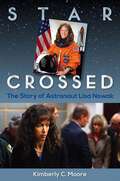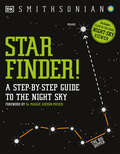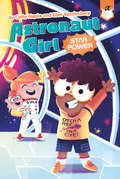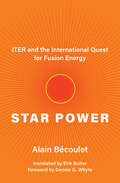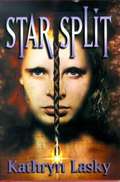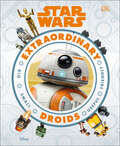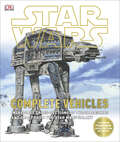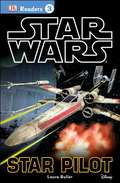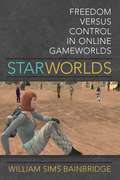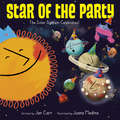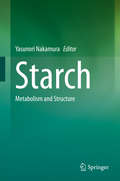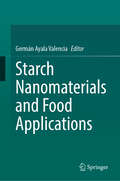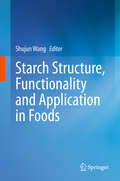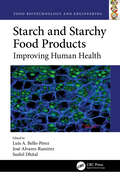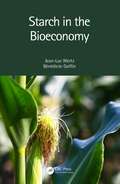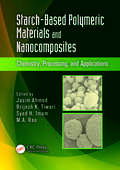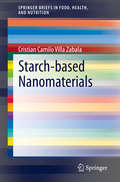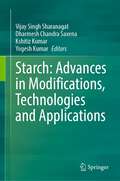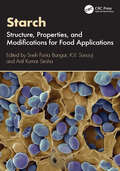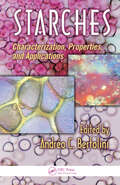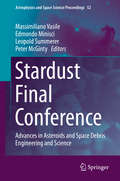- Table View
- List View
Star Bound: A Beginner's Guide to the American Space Program, from Goddard's Rockets to Goldilocks Planets and Everything in Between (Outward Odyssey: A People's History of Spaceflight)
by Emily Carney Bruce McCandless IIIStar Bound is a book for anyone who wants to learn about the American space program but isn&’t sure where to start. First and foremost, it&’s a history—short, sweet, and straightforward. From rocketry pioneer Robert Goddard&’s primitive flight tests in 1926 through the creation of NASA, from our first steps on the moon to construction of the International Space Station and planning a trip to Mars, readers will meet the people and projects that have put the United States at the forefront of space exploration. Along the way, they&’ll learn: • How the United States beat the Soviets to the moon • Why astronauts float in space (Hint: It&’s not for lack of gravity!) • How fast rockets have to go to stay in orbit around Earth • How we can &“look back in time&” through a space telescope With technology evolving and humanity&’s understanding of the universe expanding, we are entering an exciting period of space exploration. Authored by two veteran space writers with unique insights into the topic, Star Bound offers up the story of Americans in space with a focus on the cultural and societal contexts of the country&’s most important missions rather than engineering and technical minutiae. Vibrant, positive, and humorous, Star Bound is packed with facts and stories for novice space fans. And sprinkled in with the history are lists of the greatest space songs, books, movies, and more—all designed to make space exploration accessible to even the casual reader.
Star Crossed: The Story of Astronaut Lisa Nowak
by Kimberly C. MooreThe astronaut crime that shocked the world Star Crossed transports readers to the moment the news broke that one of America’s heroes, an astronaut who had flown aboard the Space Shuttle Discovery& just months before, had been arrested for a very bizarre crime. Lisa Nowak had driven 900 miles from Houston to Orlando to intercept and confront her romantic rival in an airport parking lot—allegedly using diapers on the trip so she wouldn’t have to stop. Nowak had been dating astronaut William “Billy” Oefelein when she learned that Oefelein was seeing a new girlfriend—U.S. Air Force Captain Colleen Shipman. The “astronaut love triangle” scandal quickly made headlines. The world watched as Nowak was dismissed from NASA, pleaded guilty to a felony, and received an “other than honorable” military discharge.An award-winning investigative reporter who covered Nowak’s criminal case, Kimberly Moore offers behind-the-scenes insights into Nowak’s childhood, her rigorous training, and her mission to space. Moore ventures inside the mind of the detective who studied the actions Nowak took that fateful February night. She includes never-before-told details of Nowak’s psychiatric diagnosis, taking a serious look at how someone so accomplished could spiral into mental illness to the point of possible attempted murder.This book spotlights the often-overlooked psychological health of astronauts, exploring how they are cared for by NASA doctors and what changes have been made in recent years to support space travelers on long-term missions. Expertly told, Moore’s story is a riveting journey inside the high-pressure world of one of America’s most elite agencies and the life of one beleaguered astronaut.
Star Finder!: A Step-by-Step Guide to the Night Sky (DK Children's For Beginners)
by DKA novel approach to stargazing, this stunning space book features step-by-step guides to identifying the key constellations across the northern hemisphere.What do you see when you look up into the sky? Have you ever wondered what the stars mean? Or how they are connected? Or what each constellation is called? If so, then this may be the book for you! Little stargazers will enjoy paging through this awe-inspiring astronomy book and learning all about the constellations, their forms, shapes, and stories. This stunning space book for kids explores different groups of stars specific to the Northern Hemisphere, with step-by-step guides to identifying key constellations, star-spotting, and planet spotting!Sprinkled with stardust on every page, budding stargazers aged 9 and over can explore: - A glow-in-the-dark night-sky viewer included with the book- How to follow pathfinder stars to locate constellations- Crystal clear diagrams and illustrations - Easy-to-read maps- Fact panels that explain constellations and space science- The final spread of each chapter shows all the stars in the sky with constellations unmarked so that readers can practice star-hopping- Profile's of galaxies and nebulae in the night skyStar Finder! is packed with high-quality imagery, maps of constellations, and tips to spot stars and patterns, to keep the kids enthralled, engaged and inspired. Discover striking pictures of the night sky in this amazing astronomy book for children. The innovative step-by-step approach to learning the key features of the night sky and compelling, easy-to-understand graphic style makes for the beginning of a keen interest in astronomy. This compelling guide on constellations for kids also covers planets, spotting nebulas, the milky way, shooting stars and more. A must-have volume for budding astronomers aged 9+, the informative and accessible guides featured throughout provide crystal clear instructions on recognising the constellations one by one, as well as pronunciation aids to some of the complex constellation names, and also featuring practice star maps for each season, so curious kids will find it easier than ever to navigate the night sky!
Star Power #2 (Astronaut Girl #2)
by Cathy Hapka Ellen VandenbergCan Astronaut Girl save the day with a little help from science? Find out as she and her space crew blast off on new adventures in this chapter book series!Everyone knows that humans can't travel to the sun...at least that's true in the year 2020. But when Astronaut Girl, Wallace, and the Astro crew find themselves orbiting the sun in a solar probe, they soon discover that they've gone almost one thousand years into the future! As they are zipping through space, the heat shields on their spacecraft come loose. They must find a way to fix it and get back to Earth in time for Wallace's family barbecue and before their probe gets baked like a potato!Exciting, easy-to-read books are the stepping stone a young reader needs to bridge the gap between being a beginner and being fluent.
Star Power: ITER and the International Quest for Fusion Energy
by Alain BécouletA concise and accessible explanation of the science and technology behind the domestication of nuclear fusion energy.Nuclear fusion research tells us that the Sun uses one gram of hydrogen to make as much energy as can be obtained by burning eight tons of petroleum. If nuclear fusion—the process that makes the stars shine—could be domesticated for commercial energy production, the world would gain an inexhaustible source of energy that neither depletes natural resources nor produces greenhouse gases. In Star Power, Alan Bécoulet offers a concise and accessible primer on fusion energy, explaining the science and technology of nuclear fusion and describing the massive international scientific effort to achieve commercially viable fusion energy. Bécoulet draws on his work as Head of Engineering at ITER (International Thermonuclear Experimental Reactor) to explain how scientists are trying to &“put the sun in a box.&” He surveys the history of nuclear power, beginning with post–World War II efforts to use atoms for peaceful purposes and describes how energy is derived from fusion, explaining that the essential principle of fusion is based on the capacity of nucleons (protons and neutrons) to assemble and form structures (atomic nuclei) in spite of electrical repulsion between protons, which all have a positive charge. He traces the evolution of fusion research and development, mapping the generation of electric current though fusion. The ITER project marks a giant step in the development of fusion energy, with the potential to demonstrate the feasibility of a nuclear fusion reactor. Star Power offers an introduction to what may be the future of energy production.
Star Split
by Kathryn LaskyIn 3038, thirteen-year-old Darci uncovers an underground movement to save the human race from genetic enhancement technology.
Star Wars Encyclopedia of Starfighters and Other Vehicles: Discover More Than 230 Vehicles From a Galaxy Far, Far Away!
by Brandon WainerdiThe official and authoritative guide to the starfighters and vehicles of the Star Wars galaxy – now updated to include 30 pages of new content.What’s the difference between a B-wing and an X-wing starfighter? How many legs does an AT-OT walker have? And just how fast can the Millennium Falcon fly?This latest edition covers over 230 vehicles from Star Wars movies and TV series, including The Rise of Skywalker, The Mandalorian, Ahsoka, and more! From enormous Sith Star Destroyers to Kylo Ren's TIE whisper to Din Djarin's shiny N-1 starfighter, learn all about your favorite modes of transportation from a galaxy far, far away.Discover 230+ incredible Star Wars vehicles and starfighters:Authoritative and fully authorized: Compiled and written by Star Wars experts, with incredible images and detailed fact files for each vehicleComprehensively updated: This edition builds on the original, with 70+ new entries from recent movies and TV shows (both live action and animated)A premium gift for Star Wars fans: Go deeper than ever before into the iconic starfighters and vehicles from a galaxy far, far away – an unforgettable experience for Star Wars fans of all agesEasy to navigate, with contents broken down by categories like land, sea, air, and space, and packed with informative stats such as speed, weapons, manufacturer, and so much more, the Star Wars: Encyclopedia of Starfighters and Other Vehicles has it all.© & ™ 2025 Lucasfilm Ltd.
Star Wars Extraordinary Droids
by Simon BeecroftFind the droids you know and love and discover new favorites along the way.This Star Wars guide with a twist showcases a world of droids in close-up detail. Arranged from smallest to biggest, more than 50 droids of the galaxy are revealed with stunning photography and gorgeous artwork. The evocative descriptions will delight children and let them discover amazing droid facts, such as what tools R2-D2 uses and why GNK droids make a "gonk gonk" noise! Each page features fun droid facts and detailed close-up photographs for children to pore over, including firm favorites such as C-3PO and BB-8 as well as more unusual ones such as Professor Huyang, police droids, tiny probe droids, and new The Rise of Skywalker droid D-O.Star Wars Extraordinary Droids is a perfect gift for children who can't get enough of a galaxy far, far away. The book covers droids small (quiet, little mouse droids) and big (vulture droid starfighters), kind (memoir-writing PZ-4CO) and scary (droidekas), and will be a treasured favorite book to keep.© & TM 2020 LUCASFILM LTD.
Star Wars: Incredible Cross-Sections of the Spaceships and Craft from the Star Wars Galaxy
by DKForeword authors: John Knoll, Visual Effects Supervisor at Lucasfilm's Industrial Light & Magic.For any fan who wants to explore the inner workings of the spaceships and vehicles of all six Star Wars™ movies comes this fascinating expanded edition of a fan favorite, now with new cross-section artworks and a wealth of new photos.Star Wars: Complete Vehicles is packed with visual explorations of more than fifty essential Star Wars spacecraft and landcraft, including the TIE bomber, Imperial shuttle, A-wing, B-wing, and more. Full-color cross-section artwork presents in-depth examinations of each craft's weapon systems, engines, hyperdrives, cockpits, and construction secrets, providing a never-before-seen glimpse at the vehicles that drive the Star Wars universe. Star Wars: Complete Vehicles now features new and never-before-seen cross-sections!
Star Wars: Star Pilot
by Laura Buller Tori KosaraThe galaxy is a big place, with millions of planets in it. This book is for children and shows all the coolest and most important spacecraft which the children are able to read on their own. The stories are exciting and captivating in order to develop the child's own desire to read. More text and more complex sentence structure are presented, with information spreads to help develop the reader's general knowledge. The choice of subject widens to match the broadening of children's experiences and interests.
Star Wars™ Encyclopedia of Starfighters and Other Vehicles
by Landry Q. WalkerLearn all about over 200 of your favorite Star Wars vehicles, from the A-wing to the Y-wing. Want to know how Han Solo acquired the Millennium Falcon? Don't know your X-wing from your Y-wing? Not sure what type of craft Boba Fett's ship is? Look no further than the Star Wars Encyclopedia of Starfighters and Other Vehicles.From the swamps of Kashyyyk to the deserts of Jakku, from inner-city Coruscant to the vastness of hyperspace, Star Wars Encyclopedia of Starfighters and Other Vehicles will show you the right craft for the job. Covering vehicles from across every Star Wars movie, as well as Star Wars: The Clone Wars and Star Wars: Rebels. This handy guide is full of fun facts and intriguing information, guaranteed to enthral fans for hours on end.© & TM 2018 LUCASFILM LTD. Used Under Authorization.
Star Worlds: Freedom Versus Control in Online Gameworlds
by William Sims BainbridgeStar Worlds explores the future-oriented universe of online virtual worlds connected with popular science fiction--specifically, with Star Wars and Star Trek--that have been inhabited for over a decade by computer gamers. The Star Wars and Star Trek franchises, both of which have shaped the dominant science fiction mythologies of the last half-century, offer profound conceptions of the tension between freedom and control in human economic, political, and social interactions. Bainbridge investigates the human and technological dynamics of four online virtual worlds based on these two very different traditions: the massive multiplayer online games Star Wars Galaxies; Star Wars: The Old Republic; Star Trek Online; and the Star Trek community in the non-game, user-created virtual environment, Second Life. The four "star worlds" explored in this book illustrate the dilemmas concerning the role of technology as liberator or oppressor in our post-industrial society, and represent computer simulations of future possibilities of human experience. Bainbridge considers the relationship between a real person and the role that person plays, the relationship of an individual to society, and the relationship of human beings to computing technology. In addition to collecting ethnographic and quantitative data about the social behavior of other players, he has immersed himself in each of these worlds, role-playing 14 avatars with different skills and goals to gain new insights into the variety of player experience from a personal perspective.
Star of the Party: The Solar System Celebrates!
by Jan CarrHelp throw Sun a birthday celebration in this hilarious picture book complete with nonfiction facts. Great for readers of Moonshot and for the budding astronomer in your life.The planets are throwing Sun a birthday party! Mercury wants to thank Sun for how close they are. (Being the closest planet has its perks.) Earth enjoys Sun's warmth. And all the planets want to celebrate Sun's magnetic personality.But party planning takes work. Do they even have room for all of Jupiter's moon? Don't space out. It's time for this star-studded event!Blast off with Jan Carr and Pura Belpre Award-winning illustrator Juana Medina's quick-witted and fact-filled picture book about the solar system and all of its (inter)stellar inhabitants.
Starch
by Yasunori NakamuraThis book provides a detailed overview of the current understanding of the metabolic system of starch biosynthesis and degradation in plants. The focus is on new topics regarding the functional interaction between multiple enzymes and the initiation process of starch biosynthesis, which are essential for further understanding of related metabolic features. The book also explains and discusses the distinct structures of amylopectin and amylose and the crystalline structure of starch granules. At the same time, readers will be made aware of areas where further research remains to be done, such as the regulation of starch metabolism, the fine structure of starch molecules, and the manipulation of the structure and functional properties of starch by genetic and molecular technology. Also described are aspects of the biosynthetic machinery of starch, the structure and metabolism of which have developed and been refined during the process of plant evolution. In addition, recent approaches to producing novel starches with distinct physicochemical and functional properties in gene-modified mutants and transgenic plants for industrial applications are introduced. Finally, the book elaborates on the unresolved topics, necessary approaches and future prospects to achieve a complete understanding of the regulation of starch metabolism. This volume is of great value for general scientists, students and anyone wishing to understand the specific and complicated events of starch metabolism and biotechnology. It will be especially useful for food scientists and engineers in academia and industry.
Starch Nanomaterials and Food Applications
by Germán Ayala ValenciaStarch nanomaterials can be classified as nanocrystals, nanoparticles, nanofibers, nanomicelles and nanovesicles which are produced by both "top-down" and "bottom-up" approaches. Starch nanomaterials feature advanced structures with different physicochemical properties than those found in native starches. In the food industry, starch nanomaterials can be used to reduce spoilage and oxidation in food products or as shell wall materials for encapsulating hydrophilic and hydrophobic compounds, as well as to improve physicochemical properties in foods and food packaging.Starch Nanomaterials and Food Applications presents an exhaustive analysis of the most recent advances in the production of starch nanomaterials and their use in food applications. This text brings together recent advances in the production and food applications of starch nanomaterials. All of the main starches will be covered, including nanocrystals, nanoparticles, nanofibers, nanovesicles,nanomicelles. The food applications of starch nanomaterials are covered in full, including adsorptive and encapsulating materials, emulsifiers and texturizingmaterials and functional food and packaging ingredients. A further section focuses on the human and environmental impacts of starch nanomaterials.
Starch Structure, Functionality and Application in Foods
by Shujun WangThe book summarizes the latest research on starch structures and how these structures occur during food processing and storage. Discussing the origins, multi-scale granule structures and functional properties of starch as well as starch digestion, it focuses on the relationship between starch structure and functionality, the phase transition mechanism, the molecular disassembly and self-assembly of starch during food processing and storage and their effects on starch digestion. As such, the book provides a comprehensive overview of starch structure and functionality for researchers and postgraduate students in the field of food chemistry, carbohydrate polymers, polymer chemistry, food ingredients and food processing as well as human nutrition and health..
Starch and Starchy Food Products: Improving Human Health (Food Biotechnology and Engineering)
by Luis A. Bello-Pérez, José Alvarez-Ramírez, and Sushil DhitalStarch is one of the main staples in human food, its consumption having both positive and negative aspects. The exploration and exploitation of starches from alternative botanical sources has been increasing recently due to interest in the economic and social development of tropical and sub-tropical regional economies and in support of sustainability. The book reviews existing research on various aspects of starch, including physicochemical, nutritional and functional properties, plus applications in addition to foods. Emphasis is on the various physical and chemical modifications, which are aimed at improving the properties and applicability of starch. Key Features Analyzes the state of the art of the scientific and technological problems associated with starch Describes various applications of starch in foods Provides a broad view on the field of starch and starchy foods
Starch in the Bioeconomy
by Jean-Luc Wertz Bénédicte GoffinStarch is the most widespread and abundant reserve carbohydrate in plants and is unique in that it can be used for the production of food, materials in bio-based products, and energy. Starch in the Bioeconomy covers the structure, biosynthesis, biodegradation, properties, and applications of starch in the context of the bioeconomy. The book Describes the present state of cognition of the starch granule Discusses physicochemical aspects and digestibility Considers physical, chemical, and biochemical processes to yield a variety of starch substrates Examines starch-based products including bioethanol, plastics, and composites and their use in various sectors including food, materials and energy Covers the valorization of starch as a pillar of the bioeconomy The book is aimed at researchers and industry professionals focused on the development of starch science, technology, and economics. Built on a reliable and well-documented base of information, the book presents the paths that remain to be taken to decipher this still mysterious resource that has contributed so much to the rise of humanity.
Starch-Based Polymeric Materials and Nanocomposites: Chemistry, Processing, and Applications
by Jasim Ahmed Brijesh K. Tiwari M. A. Rao Syed H. ImamIn recent years, much attention has been focused on biodegradable polymers from renewable resources. Due to its availability and low cost, starch is a promising candidate among biopolymers for use in biodegradable packaging materials and for other purposes. Starch-Based Polymeric Materials and Nanocomposites: Chemistry, Processing, and Applications
Starch-based Nanomaterials (SpringerBriefs in Food, Health, and Nutrition)
by Cristian Camilo Villa ZabalaStarch is one of the most important natural and biodegradable polymers on Earth. It is used by many plants as an energy reserve, and due to its biocompatibility and relatively easy structural modification, it is widely used in the cosmetic, food, pharmaceutical and materials industries. In recent years, interest in starch has increased due to the development of starch-based nanomaterials. Nanomaterials are small particles—diameters ranging from 10 nm to 500 nm—that can be highly crystalline (nanocrystals) or completely amorphous (nanoparticles). Owing to their versatility, starch-based nanomaterials can be used as carriers of bioactive molecules to improve medical treatments or nutrient absorption. They can also be used as reinforcement in composite materials, improving their mechanical and barrier properties, and new potential applications are continuously reported in the literature. This brief provides a quick guide to the exciting world of starch-based nanomaterials, including their chemical and physical characteristics as well as their synthesis methods and most common applications.
Starch: Advances in Modifications, Technologies and Applications
by Vijay Singh Sharanagat Dharmesh Chandra Saxena Kshitiz Kumar Yogesh KumarStarch is one of the major components responsible for the structure of final food products. A recent report by Industrial Starch Market predicts the industrial starch market to reach about 106.64 billion by 2022. The major portion of the starch volume will be contributed by conventional sources like maize, wheat and potato. These native starch sources are well capable to meet the industrial requirements. However, modification of starch brings lot of positive changes in functional and structural properties of starch. As compared to their native counterparts, modified starches are gaining a significant market growth due to their enhanced functionalities and applications. Starch: Advances in Modifications, Technologies and Applications provides comprehensive coverage of the most recent advances in the modification techniques, their impact on functionality of starch and potential application food industries. Starch is a vital ingredient for food processing industries and it has been covered thoroughly in different books. However, none of the books currently on the market have covered the most recent advances in modification techniques and their derivatives including the functional, engineering, thermo-pasting, rheological, structural and morphological properties of starch. This text comprehensively covers almost all the starch modifications, reviewing the derivatives of modification techniques and compiling all the changes in properties to provide an understanding and perspective of these innovative applications. From the history of starch production to current chemical and physical modifications, this book offers researchers all the information they need on starch modifications in a single source.
Starch: Structure, Properties, and Modifications for Food Applications
by Anil Kumar Siroha Sneh Punia Bangar K. V. SunoojStarch is the principal source of stored energy in plants, and its chemical composition varies depending on the botanical source of the starch. Starch plays a significant role in determining the structural characteristics of finished food products. "Starch: Structure, Properties, and Modifications for Food Applications" explores the comprehensive overview of the basic structure and properties of starch as well as the modification of starch with physical, chemical, and enzymatic methods. Each chapter presents an in-depth review of a specific research area updated with current research. Chapters of this book provide comprehensive information regarding starch modification, which will help to design new, healthy starch-based food products.Key Features: This book will cover the functional characteristics of conventional and non-conventional starches It covers the different methods of starch modification, including physical, chemical, and enzymatic methods The latest information on the properties of modified starch is from different sources This book will explore the current and emerging application trends of modified starches With contributions from esteemed researchers worldwide, this book serves as an invaluable resource for students, food technologists, researchers, and industry professionals seeking to deepen their understanding of modified starches and their diverse applications. We hope that the insights offered within these pages inspire new avenues of research and innovation, ultimately contributing to continued advancement in food technology.
Starches: Characterization, Properties, and Applications
by Andréa C. BertoliniStarch is one of the major polysaccharides employed as biopolymers by the food industry, and its wide range of applications has resulted in intense research of starch structure and technology. Written by an outstanding multidisciplinary team with complementary expertise in both academia and industry, Starches: Characterization, Properties, and Appl
Stardust Final Conference
by Massimiliano Vasile Edmondo Minisci Leopold Summerer Peter McGintySpace debris and asteroid impacts pose a very real, very near-term threat to Earth. In order to help study and mitigate these risks, the Stardust program was formed in 2013. This training and research network was devoted to developing and mastering techniques such as removal, deflection, exploitation, and tracking. This book is a collection of many of the topics addressed at the Final Stardust Conference, describing the latest in asteroid monitoring and how engineering efforts can help us reduce space debris. It is a selection of studies bringing together specialists from universities, research institutions, and industry, tasked with the mission of pushing the boundaries of space research with innovative ideas and visionary concepts.Topics covered by the Symposium:Orbital and Attitude Dynamics ModelingLong Term Orbit and Attitude EvolutionParticle Cloud Modeling and SimulationCollision and Impact Modelling and Simulation, Re-entry Modeling and SimulationAsteroid Origins and CharacterizationOrbit and Attitude DeterminationImpact Prediction and Risk Analysis, Mission Analysis-Proximity Operations, Active Removal/Deflection Control Under Uncertainty, Active Removal/Deflection Technologies, and Asteroid Manipulation
Starfield Visual Compendium
by Bethesda SoftworksA hardcover full-color book filled with concept and development art on the game Starfield!From the indomitable Bethesda Softworks comes the highly awaited art of the smash-hit game: Starfield. Unveil the wonders of the cosmos with this beautiful 368-page hardcover exploring the vast galaxy waiting to be discovered.In the year 2330 humanity can be found far from Earth, within the expansive Settled Systems. Step into the universe of Starfield and reveal the innerworkings of the galaxy&’s most powerful factions. Uncover galactic artifacts and explore thousands of extraordinary worlds.

